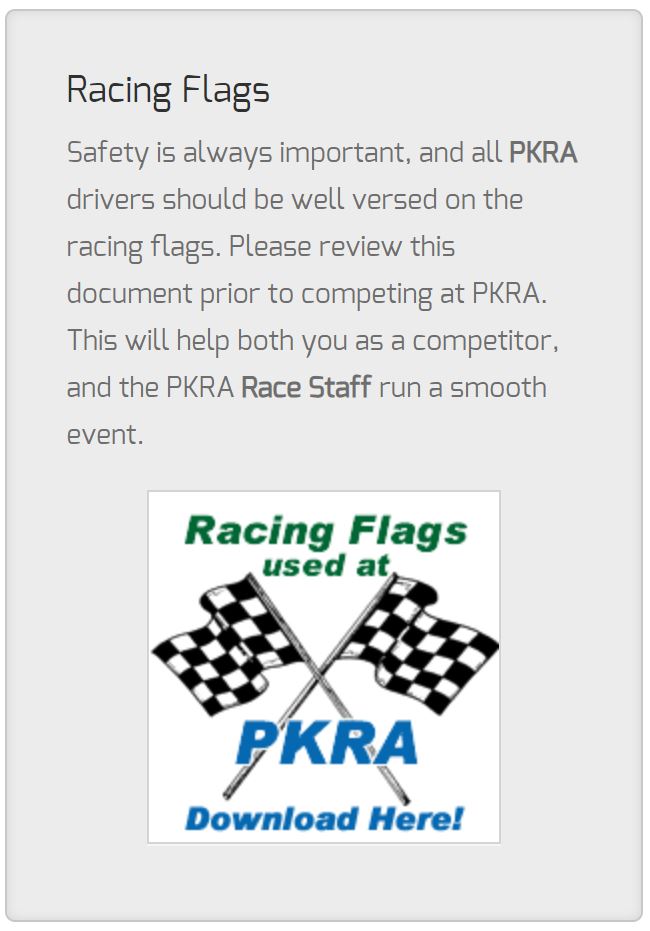PKRA Racing
A Modern Sprint Karting Club with events all year round and multiple layout options for all classes and skill levels.
- Multiple Layout Options
- Multiple Age Categories
- Experienced Race Directors
- Food Concessions Available
- Free Spectator Entry
For additional information or to join our club, and start enjoying the benefits of membership, please visit the following links.
Race Consent and Waiver Forms
All Adults (Drivers and Non-drivers 18 or older) entering the extended pit area must fill out and sign the NKA Adult Waiver form for each race:
All Minors (Drivers and Non-drivers not yet 18) entering the extended pit area must have their parent or guardian fill out and sign the following forms:
The Annual NKA Parental Consent form must be filled out once per calendar year. If one has not been filled out and provided to PKRA yet this year, you must fill it out and sign it.
The NKA Minor Waiver form (aka Minor Report form) must be filled out and signed for each race.
Live Timing
Live Timing is available for PKRA Club Races through Alpha Timing. This will be available during the race, and for a short time afterwards.
Unofficial Race Results will ultimately appear in Alpha Timing under the particular PKRA Race. These are unofficial, and will not show the penalty descriptions. Official Results are on the PKRA Racing / Official Race Results.
Note that RaceHero has discontinued that application entirely.
Personal Safety Equipment Required for Karting
- Full-Face Racing Helmet with proper certification – up to one cycle older than current per rules
- Neck Collar for all drivers
- Abrasion Resistant Gloves
- Abrasion Resistant Clothing – Karting Suit or Jacket and Jeans
- High Top Shoes with Socks
- Under 12 – SFI Approved Chest Protector
- Long Hair must be adequately restrained (tucking into race suit insufficient)
Highlighted Rules
General:
- Pets must be on a leash no longer than 6ft, in a closed vehicle (no access to outsiders), or carried in the arms, and fully under your control at all times. If an animal bites someone, the pet will be banned forever, and the person/family will be suspended/banned for at least 30 days.
- There are no glass bottles allowed at PKRA at any time, due to park restrictions
- No drinking of alcohol is allowed by anyone until all racing/sessions have been completed.
- Neck Braces are required at PKRA for all drivers for practice and races.
- All two cycles karts must have air boxes (silencers) for practice and races.
Race Day:
- PKRA uses NKA rules as the primary rule set, with some local PKRA overrides (neck braces required for all, class specs).
- Everyone in the Pit area (beyond the spectator area by bathrooms) must purchase a pit pass for insurance purposes.
- No one is allowed past the pit out red line without grid boss permission.
- No one is allowed past the red line at the scales besides the driver (kid kart excepted).
- There is no driving from B Grid to A Grid. Karts are unloaded in B Grid and Pushed to A Grid.
- Front row pit spots are premium spots and require either an annual or one time fee.
- New drivers must have an “X” on their rear number and start from the back for 3 races.
- There is no passing under yellow/caution. This includes the outlap and after the checker.
Transponders Required for Racing
MyLaps transponders are required for all karts participating in races. You can use your own, or rent one from PKRA.
All MyLaps/AMB transponders for Karts (Yellow) will work with our system. Some MyLaps/AMB transponders designed for other sports may also work. For example, those designed for Car/Bike (Red) appear to work, but MotoCross MX (Orange) don’t. See page 35 of the Orbits Sports Timing manual which indicates that those from other sports are incompatible.
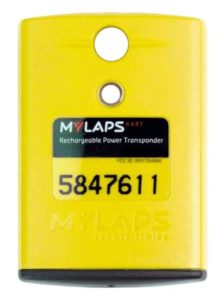 The old AMB TransX 160 transponders work well, but are no longer available. These are the type the club rents, and you’ll need a bracket like this installed on your kart:
The old AMB TransX 160 transponders work well, but are no longer available. These are the type the club rents, and you’ll need a bracket like this installed on your kart:
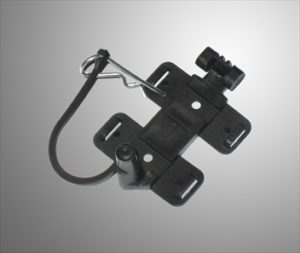
.
.
.
The new X2 and TR2 transponders require a subscription (1, 2 or 5 years), and need to be for “Kart” (Yellow).
The X2 requires a Racekey and uses a different bracket. The X2 can be run off of external battery power.
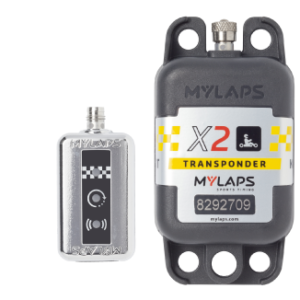
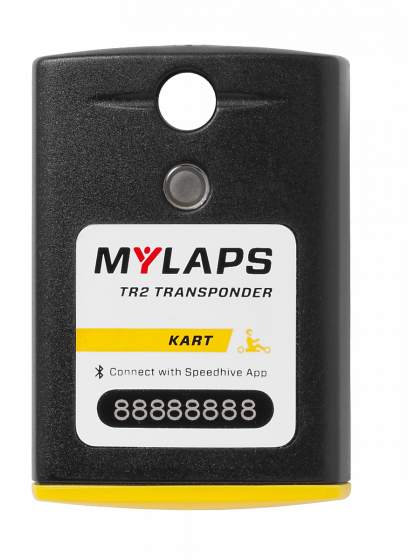
PKRA requires the transponder to put it on the back of the seat.
We use the transponder for Timed Practice to set the Qualifying order, and for Qualifying to set the order for the first Heat. The transponder is used for Heats and Mains in conjunction with manual scoring.
During Qualifying sessions, if a rented transponder fails, you’ll be allowed to re-qualify, but not if your own transponder fails or you forgot to put one on. If qualifying order is set by Timed Practice (aka Warm-Up), you’ll start at the back of qualifying if your transponder fails, regardless of whether it is your own or rented from PKRA.
Spec Tire Program
All race entrants must use the spec tires for all PKRA Club Races, which are Hoosier tires for all 4 Cycle classes (contract through April 2026), and beginning with the 2023 summer season, Mojo tires for all 2 cycle classes (contract through April 2026). Refer to the Racing Classes page for the specific compounds and sizes each class must run.
Race Day Procedures
The following are a summary of race day procedures for PKRA Club Races.
(They differ somewhat from Practice Day Procedures)
- The outside gate is open to bring in your vehicle at the “Gates Open” time set in the Schedule
- Temporarily park your vehicle in the outside parking area, and proceed to the registration window.
Sign waivers and obtain wrist band pit passes (and transponders if applicable) before proceeding into the pits. - Anyone in the pit area must have a pit pass Wrist Band. These can be purchased with pre-registration (included for the driver), or purchased race day at registration. After registration closes, pit pass Wrist Bands are purchased at the front desk near the Pedestrian Entry – see the Pit Map.
- Front Row spots (#1-59) require purchase – see Race Prices. Many Front Row spots are reserved – see the Pit Map.
- Back Row spots are free on race day, but some are also reserved – see the Pit Map.
- Review the Pit Map and park in a spot not reserved to someone else on a first come, first served basis.
- You must leave a lane between the front and back row pits as a fire lane – see the Pit Map. Also do not block the paved paths for kart transport.
- The vehicle gate closes after the drivers meeting (see race day Schedule). Visitors coming later will park in the public parking area, and must purchase a wrist band pit pass to enter the pit area. The gate will remain closed until the Kid Kart Main is completed.
- Overnight camping is possible along the north fence of the outside parking lot, and trailers can be left overnight as long as procedures are followed and additional fees paid (see Park Overnight Rules page). Under no circumstances may anything be dumped (including grey water) in any area of the park.
- Temporarily park your vehicle in the outside parking area, and proceed to the registration window.
- Check-in for Pre-Registrations and Race Day Registrations begin at the time set in the Schedule.
- See the Pit Map for the location of Registration.
- Prices are higher for onsite, raceday registration.
- For classes that allow different engines (Tag100, Shifter), you will register for the particular class, and not the specific engine. If there are differences in weight, they will be marked on your pre-tech tag in pre-tech.
- You will need to have a transponder (see requirements above), and one may be rented. You will be asked to provide a credit card or drivers’ license for us to hold until the transponder is returned. The transponder may is used for Timed Practice (if applicable), Qualifying, Heats, and Mains.
- For insurance purposes, anyone in the pit area requires a pit pass Wrist Band.
- Registration closes about 1/2 hour before Practice ends per the Schedule.
- A Pre-Tech Safety Inspection is mandatory before you can take your kart onto the track.
- Pre-Tech opens the same time as Registrations.
- See PKRA Club Rules as well as NKA rules for kart and other safety requirements, as well as Class Specifications
- Bring your helmet – it may be checked for compliance.
- See the Pit Map for the location of the Tech Area
- New drivers will need to have an “X” over their rear facing number, and start from the back for the first three races. You may petition the race director to waive this.
- The Race Day Warm-up / Practice Session begins according to the Schedule.
- Familiarize yourself with the particular configuration layout, and where to exit into the pits.
- Be sure to install your transponder for warm-up, as a test for timing and scoring. Qualifying order is also sometimes set by warm-up times.
- Warm-up and Qualifying order is currently determined by the current point standings for that class, but this is not enforced by the grid boss.
- Bring your kart to the back of the “B” Grid and unload it there. Move your kart stand outside of the grid area (pit spot 22 is reserved for this).
- There is no running of engines on the “B” Grid.
- There is no re-fueling in either A or B Grid.
- Karts are pushed to the “A” Grid once the prior group has exited the pits – no driving (accommodations for push-stated karts).
- You must follow the directions of the Grid Boss.
- When exiting the track from race day warm-up, you will go through the scale area, and cannot go out for further warm-up. Slow down, and stop in line before the scale. There is no driving on the scale. Check your weight, as being too light means a DQ in Qualifying or races. You can also check your rear width with the provided templates.
- The Drivers Meeting is mandatory for all drivers, and begins shortly after the end of practice.
- The Drivers Meeting on the “A” Grid (possibly to the East side in very hot weather).
- A parent/guardian or mechanic must be present with any minor drivers.
- Qualifying procedures are similar to Practice
- Check the board for your qualifying order if it was set by timed practice.
- You will be spaced out coming out of the pits. No bump drafting is allowed during qualifying.
- At the scales, minimum weight for your class will be enforced, width may be checked, and your tires will be marked. You must use this same set of tires for the remainder of this race. Violations for any of these are grounds for Disqualification.
- No one is allowed to come to the scales unless approved by the race official running the scales. No one may pass anything over the fence.
- You will also need to go through Tech – follow the instructions of the race official running the scales. Failure to go through Tech when required will result in disqualification for that session. Fuel is almost always checked, and random levels of engine tech may done. Take direction from the official at the scales, but typically all go through tech after qualifying, and only the top finishers go through tech for Heats and Mains.
- Heat / Race procedures
- Review the sheet on the board to find your starting position.
- For CW configurations, Pole and odd numbers line up to the right (on-track this will be the inside going through turn 1)
- For CCW configurations, Pole, and odd numbers line up on the left (on-track, this will be inside going through turn 12)
- For “earned pole” (position set from qualifying or a previous heat), you may choose the opposite side. You must tell the grid boss that is what you are doing. In this situation, only the front row changes; row 2 and back must maintain their assigned position.
- If possible, line up on the “B” grid in the same position you will be in on the “A” grid, before pushing forward.
- If you have trouble starting your engine, raise your hand to alert the grid boss.
- There is no passing under a yellow flag. Note that there is always a yellow flag on the warm up lap and after receiving the checkered flag.
- When leaving the pits for a CW configuration, you proceed left out of the pits for a warm up lap (not quite a complete lap), and after crossing the start finish line, you proceed around the “bull ring” (small oval) at slow speed in preparation for the start. In a CCW configuration, you will proceed right and take a full lap after crossing the start finish line before proceeding around the “bull ring” at a slow pace.
- If you are out of position and trying to get back where you should be while going around the bull ring, raise your hand to alert the race officials, but the start will not be unduly delayed for you.
- Procedures documented here summarize the rules, but do not constitute the rules themselves, and it is ultimately your responsibility to familiarize yourself with the NKA and PKRA rules.
- Starting Procedure
- The starting procedure used by PKRA is based on NKA 10.9.3 Race Start Sprint.
- The Pole sitter sets a slow pace around the “bull ring”.
- Coming out of the bull ring corner, all drivers must move into and remain in their respective tram lanes (shifter start box outlines) until the race has started. NKA time penalties will be assessed for infractions.
- PKRA uses a start zone per NKA rule 10.9.3.4. Make sure you understand the placement, and ask if it’s not clear to you.
- The first line defines the earliest point the pole sitter may begin to accelerate and start the race. Currently, this is the start/finish line.
- The pole sitter starts the race by accelerating prior to the second line / set of cones which represents the end of the start zone. Frequently, a red plastic barricade is used to mark this point.
- The flag official will wave the green flag when the pole sitter starts the race by accelerating (or when the pole sitter reaches the end of the start zone if for some reason they haven’t accelerated). This announces the race has begun.
- In rare cases, the flag person may wave off the start prior to the pole sitter reaching the start zone by moving their upright hand or yellow flag in a circular motion. In this case, the drivers will go around the “bull ring” again, correcting any issue that caused the start to be waved off. This might be the pace being too fast, or karts being out of position.
- The off-pole (#2) driver must not be in front of the pole driver going into or out of the start zone, otherwise a jump start penalty will be assessed against the off-pole driver.
- If the pole sitter starts to accelerate prior to the start zone, a jump start penalty will be assessed against the pole sitter.
- Pushing is not allowed before the race has started. NKA penalties will be assessed. If you are being pushed, putting your arm up will alert race officials, but the race will not be waved off; penalties will be assessed as warranted.
- Bump drafting is allowed during heats/races, but any contact detrimental to another driver is subject to penalties.
- In a Red Flag situation, corner workers now have red flags which indicate the race is stopped. In this case:
- Raise your hand and lift off the throttle. Then slowly brake.
- Come to a stop as soon as it is safe and reasonable to do so.
- Officials may direct you to stop in a particular place. Obey their directions.
- There is no working on karts during a red flag.
- There is no contact allowed on the outlap or inlap. There should be no excuse for such contact, and weaving to warm up tires is at your own risk. Penalties for contact coming into the pits after the race will be especially harsh.
- For the main race, only the top finishers are generally asked to go through tech – follow the instructions of the race official running the scales. Failure to go through Tech when required will result in disqualification.
- Fuel is almost always checked at some point (Qualifying, Heats, Mains), and random levels of engine tech are also done. Disqualification (DQ) in the main race results in 0 points, and the race cannot be dropped from the championship. DQ could come from any rules violation, but particularly under weight, over rear width maximum, illegal fuel, substituting tires, or specific engine requirement violations.
- After completing the Main Race
- Remember to turn in your transponder at Tech to get your credit card or license back.
- Take any used tire and fuel containers with you. County rules prohibit leaving them or putting them in the trash.
- General
- A driver may be called to the tower to help the Race Director understand an on-track incident. In this case, proceed to the front of the “A” grid and ask permission of the Grid Boss. The Grid Boss may make you wait until it is deemed safe and/or until the Race Director is ready. Under 18 drivers must bring an adult representative with them.
- Tech decisions may be protested, but the decision of the Race Director is not subject to appeal.
- A driver will be deemed to have competed if they “take a green flag” for qualifying, heat, or a race. They will receive at least last place points (barring a final DQ), and their fees will not be refunded.
- You must be civil and respectful to all Race Officials. Threatening or abusive language by the driver or associated persons to anyone, but especially race officials will result in disqualification of the driver and/or expulsion. Serious incidents will be referred to the PKRA Board of Directors for consideration of further action.
- Adults are prohibited from discussing racing conduct with minors not in their family.
- Everyone must stay behind the line at the from of the “A” grid, and spectators need to view from one of the spectator areas. If there is a serious incident on-track where the paramedic is called out on the track, parents must wait until given permission to go out on track. Wait until the Grid Boss gives you permission.
- Tires and fuel can may not be left at the track.
- Driving of karts in the pits and parking areas is strictly prohibited.
- Pets must be on a leash no longer than 6ft, in a closed vehicle (no access to outsiders), or carried in the arms, and fully under your control at all times. If an animal bites someone, the pet will be banned forever, and the person/family will receive at minimum an automatic suspension/ban for at least 30 days.
- No motorized or non-motorized scooters, skateboards, bikes or similar devices.
- No radio controlled cars.
- No glass bottles in the park at all.
- No Alcohol until after the end of racing or practice and all karts have cleared the track and tech inspection.
Protest Procedures
Protest procedures are covered in the PKRA Club Rules, under 500.43, 500.44, 500.45, and 500.46
Highlighted Protest Rules
-
- You must file a protest within 30 minutes of the completion of that race segment, and must be filed by the driver (parent) in the same class. You may protest tech items or driving conduct.
- If your protest requires tech teardown, you will be required to pay $200 in cash, which will be returned if the protest is upheld.
- You’ll need to describe the rule (PKRA, NKA, and/or Engine Mfg) that you believe was violated, and refer to that paragraph number.
- If you are protesting engine tech items, you’ll need a copy of the applicable engine rules. See the Class List for links to specific engine rules.
- Tech will have protest forms.


